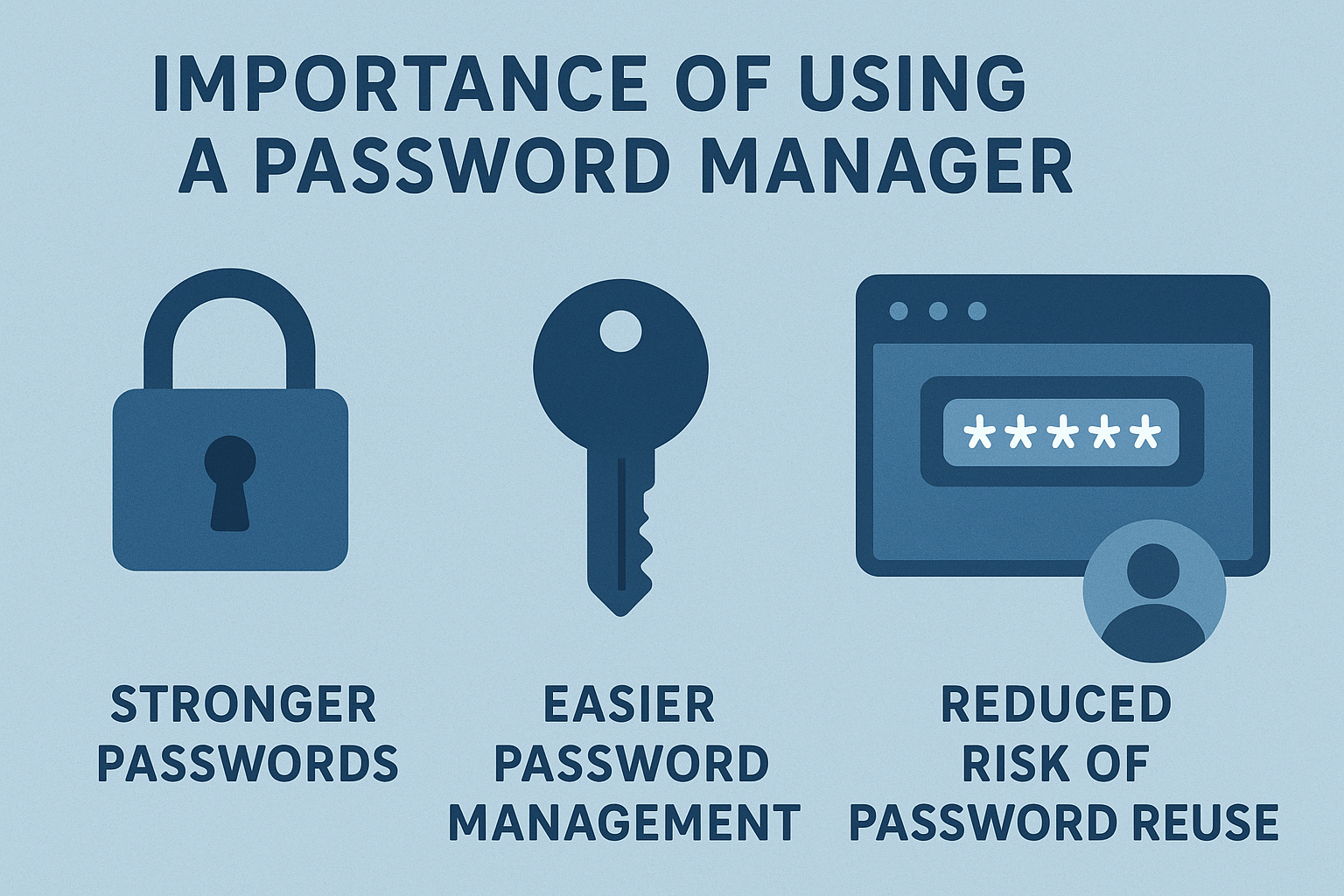Introduction: The Growing Threat of Password Fatigue
In today’s hyper-connected digital world, the importance of using a password manager cannot be overstated. Most people manage dozens of online accounts—emails, banking, shopping, and social media. With so many logins to remember, many resort to weak or repeated passwords, leaving themselves open to hackers.
According to a 2024 cybersecurity report by NordPass, the average internet user has over 90 active accounts, yet 65% reuse passwords across multiple sites. This dangerous habit can lead to massive data breaches, identity theft, and financial losses. A password manager solves this problem by creating, storing, and managing complex passwords securely.
What Is a Password Manager?
Definition and Core Functions
A password manager is a digital tool that securely stores your login credentials in an encrypted vault. It automatically generates and fills in complex passwords when needed, saving you from the hassle of remembering each one.
These managers come in both cloud-based and local storage versions. Cloud-based ones (like 1Password or Bitwarden) sync your data across all devices, while local ones keep everything offline for extra control.
How Password Managers Work
When you create a new account online, your password manager suggests a strong password—often a random mix of letters, numbers, and symbols. It encrypts that password using military-grade algorithms like AES-256 and stores it securely. The only password you need to remember is the master password, which unlocks your vault.

The Risks of Weak and Reused Passwords
Common Cybersecurity Threats
Weak passwords are cybercriminals’ favorite entry point. Attackers use tools like brute-force attacks, keyloggers, and credential stuffing to exploit reused credentials. Once they get access to one account, they can potentially unlock others using the same login information.
Real-World Data Breaches Caused by Poor Password Habits
Recent breaches at major companies like LinkedIn, Yahoo, and Facebook have shown how dangerous password reuse can be. Millions of passwords were leaked due to users relying on predictable patterns such as “123456” or “password.”
These breaches underscore why it’s essential to adopt password managers—they make strong password practices effortless and automatic.
10 Reasons You Should Use a Password Manager
1. Stronger, Unique Passwords for Every Account
A password manager generates unguessable passwords, ensuring each one is unique. You’ll never have to memorize them or rely on unsafe variations.
2. Protection from Phishing Attacks
Because password managers auto-fill only on legitimate sites, they can help you avoid phishing attempts that mimic login pages.
3. Encrypted Vaults for Maximum Security
Your passwords are stored in encrypted form, meaning even the password manager provider can’t access them.
4. Convenient Auto-Fill and Synchronization
Password managers save time by filling in logins automatically and syncing across your devices—phone, tablet, and computer.
5. Secure Sharing of Login Credentials
Need to share Netflix or business credentials? Most password managers offer encrypted sharing, eliminating the need to send passwords via text or email.
6. Multi-Device Access and Backup
Whether you’re switching phones or logging in from work, your passwords travel securely with you.
7. Breach Alerts and Security Monitoring
Premium password managers monitor the dark web and notify you instantly if one of your accounts is compromised.
8. Time-Saving and Stress Reduction
No more “Forgot Password?” frustration. One master password unlocks everything.
9. Simplified Password Recovery
Even if you forget your master password, secure recovery options like biometric authentication or recovery keys are available.
10. Compliance and Professional Use Cases
For businesses, password managers help meet data protection and compliance standards such as GDPR and HIPAA.
Choosing the Right Password Manager for You
Free vs. Paid Options
Free versions like Bitwarden or NordPass Free are great for beginners, while paid ones offer premium features like dark web monitoring and priority support.
Key Features to Look For
- AES-256 encryption
- Secure sharing capabilities
- Cross-platform compatibility
- Zero-knowledge architecture
Trusted Password Manager Examples
Some of the most trusted password managers include:
- 1Password
- Bitwarden
- Dashlane
- LastPass
- Keeper
(For an independent comparison, visit PCMag’s password manager reviews.)
How to Use a Password Manager Safely
Setting Up Strong Master Passwords
Your master password should be long, unique, and not used anywhere else. A good tip is to create a passphrase (like “BlueCarrotsDanceAtMidnight”).
Enabling Two-Factor Authentication (2FA)
Adding 2FA provides an extra layer of protection—requiring both your master password and a one-time code.
Avoiding Common Mistakes
Never write your master password down or share it. Also, back up your vault to prevent data loss.
FAQs on Password Managers
1. Are password managers really safe?
Yes. Password managers use strong encryption that even their developers can’t bypass.
2. What happens if someone steals my master password?
If you’ve enabled 2FA, they still can’t access your vault without your secondary verification.
3. Are free password managers good enough?
Yes, but paid versions often provide extra features like encrypted sharing and data breach alerts.
4. Can I use a password manager on multiple devices?
Absolutely. Most reputable services sync seamlessly across all your devices.
5. Do password managers work offline?
Yes, many do. You can access stored passwords even without an internet connection.
6. Which password manager is best for families or teams?
1Password Families and Bitwarden Teams are top-rated for group sharing and collaboration.
Conclusion: Strengthen Your Digital Security Today
The importance of using a password manager extends far beyond convenience—it’s about safeguarding your digital identity in a connected world. By automating password creation and storage, you eliminate one of the biggest vulnerabilities in online security: human error.
Start today with a trusted password manager and take control of your cybersecurity future—because your online safety is worth protecting.




